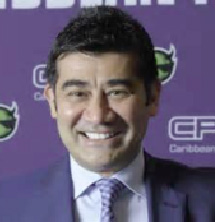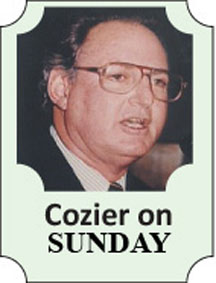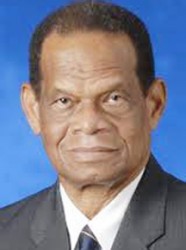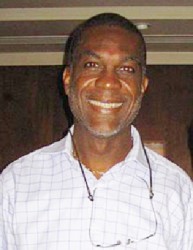THERE were a host of inevitable questions hanging over the Caribbean Premier League when Julian Hunte, then West Indies Cricket Board (WICB) president, announced last year that it was selling its annual Twenty20 tournament to Verus International, a wealth management organization based in New York and Barbados.
The extravaganza that the newest, and shortest, form of the game has become on every point on cricket’s map got underway in Barbados and Guyana during the week. These are early days yet but several of the initial reservations have diminished, if not disappeared completely.
For four years, the WICB had failed to find a sponsor for any of its three major tournaments. Suddenly, they are falling over each other to have their names attached to the CPL – the Limacol Caribbean Premier League to give it its full, sponsored name. It set out with what it called a “full set of commercial partners”, West Indians and internationals. Even after that, another couple have been added.


Ajmal Khan, Verus’ main man, boasted from the start that it would be “the ultimate cricket carnival”. With the fireworks, the gyrating cheerleaders, the calypsonians and dub artists belting out their hits, and, at Kensington, Mac Fingall and his motley crew perform ing to the delight of those in the Greenidge and Haynes Stand, that’s what it has been.
So too, in their own way, in similar leagues in India, Australia, England and South Africa but not quite as it is such a cosmopolitan mix of cultures as in the West Indies. Competition from Barbados’ long established annual Crop Over celebrations has made no difference to the attendances. Nor has the state of the economies that so concerns politicians but not, it seems, their constituents intent on having a good time.
And what about the cricket?
Test matches they are decidedly not. That is the purest form of the game, its foundation, and cannot be replaced as such. It’s not even the 50-overs an innings variety.

It is simply part of an entertainment package in which what happens in the middle is accentuated by what’s going on beyond the boundary. There have been long sixes and power-laden fours to set off the waving of thousands of 6 and 4 cards, one amazing catch by a fielder with bronze-dyed hair who is usually a `keeper and some tight bowling by spinners.
Also, for the first time, players from other countries are participating in the Caribbean in the same teams alongside West Indians. The Indian Premier League and the Big Bash have already shown the benefits of such cross-fertilization.
All this has come against a backdrop that might well have dimmed the enthusiasm of Khan and others and scuppered the project even before it could get off the ground.
There were bound to be doubts from the start over whether the idea could attract sponsors or gain the support of governments, public and media so necessary for success, especially when it gave itself just nine months to get things rolling.
Even though Hunte emphasized that the WICB had undertaken due diligence and thoroughly verified Verus’ credentials, memories of the WICB’s bitter experience with Allen Stanford’s collapsed Twenty20 were still strong.
The CPL launch coincided with the first whispers of match fixing in the Indian Premier League (IPL) and the financial problems of the Bangladesh equivalent.

More than just eyebrows were raised by a statement from the Barbados Central Bank warning (as it put it) that Verus International “was not licensed to engage in merchant banking, or any other activity regulated” by the Bank “in or from within Barbados”, adding that anyone transacting business with Verus “did so at their own risk”.
The prospects of global television coverage also appeared slim. It would, after all, coincide with the high-profile Ashes series in England and India’s ODIs in Zimbabwe.
If the prospects of staging it in the rainy season did not enter the thinking, faltering economies and tiny populations of the small island states that comprise the cricketing Caribbean might have. Still, Khan declared that he would invest “whatever it takes, in the hundreds of millions” to make it work.
Millions – if not hundreds of millions – have been invested in establishing the Limacol CPL but not by Verus itself. The Irishman Denis O’Brien, head of Digicel, is now listed as its owner; Ajmal Khan as the founder.
Significantly, Digicel, the mobile phone company that covers the Caribbean, was formerly title sponsor for West Indies international cricket before downgrading to just team sponsor early this year, no doubt just when it was involved in the CPL take over.
The message is clear; it sees more value in running an event on its own – especially one of such potential – than tied to the WICB.
Even so, the WICB and West Indian players stand to financially benefit to the overall tune of US$800,000.
Retainer contracts worth US$360,00 are reserved for regional players. Teams earn US$25,000 for each victory; US$250,000 goes to the overall champion. Each Man of the Match gets US$1,000, the longest six US$500, the batsman with the highest run rate the same.
But what about the up and coming cricketers?
Ian Chappell is among the many who believe that too much Twenty20 is spoiling the techniques of young batsmen. Australia’s particularly. Although Michael Holding’s aversion to the concept of Twenty20 is so strong he won’t commentate on it, has agreed to be a CPL ambassador.
Holding explains what appears to be a contradiction: “The CPL is looking at a development programme which they will start rolling out in January 2014, I understand. They will have about 60 young cricketers, 10 from each of the six franchise regions, who they will put on contract and create programmes to improve their cricket. That is what I am interested in…if we can develop some young cricketers in the Caribbean, even if a lot of them are tempted to play Twenty20 cricket, then maybe we can still find one or two who are quite happy and even capable of playing Test cricket too.”
Nicholas Pooran, at 17 the Limacol CPL’s youngest player, made an immediate impact with his six sixes in a 24-ball 54 on Wednesday for the Trinidad & Tobago Red Steel against the Guyana Amazon Warriors (brilliant names, these).
It makes him one to watch; he might just turn out to be the Test player Holding envisages. But the young Guyanese, Jonathan Foo, then a complete unknown, was a similar sensation in the WICB’s Twenty20 a few years ago. Remember him?





